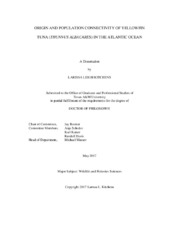Origin and Population Connectivity of Yellowfin Tuna (Thunnus albacares) in the Atlantic Ocean
Abstract
Understanding the stock structure and population connectivity of migratory fishes is crucial to their effective conservation and management. Yellowfin tuna is a highly migratory species that is currently managed as a single panmictic stock in the Atlantic Ocean; however, uncertainty remains regarding their population structure in this region, particularly concerning the degree of mixing among spawning populations. Analysis of naturally occurring chemical markers in otoliths provides a valuable means to reconstruct a fish's environmental history and has proven to be an effective approach for examining the population structure of marine fishes. The purpose of this research was to use otolith chemistry (trace elements and stable isotopes) to address gaps in our knowledge regarding the connectivity and mixing of yellowfin tuna populations in the Atlantic Ocean. Objectives were to develop a baseline of chemical signatures for young-of-year (YOY) yellowfin tuna from all probable nursery areas in the Atlantic Ocean, estimate the origin of adult yellowfin tuna collected from multiple regional fisheries using this baseline, and assess interannual and age-specific variability in the contribution rates of each nursery to the Gulf of Mexico fishery. Results indicated that significant regional differences in chemical signatures existed for each year class of YOY yellowfin tuna in this study, indicating that the baseline of nursery signatures created here can serve as an effective tool for assigning older yellowfin tuna to their nursery of origin. Mixed-stock analysis revealed that all adult yellowfin tuna captured in the Bahamas originated in the Gulf of Mexico, while individuals from the Caribbean Sea and Cape Verde primarily originated in eastern Atlantic nursery areas. Additionally, significant mixing was detected among yellowfin tuna in the Gulf of Mexico, as approximately half of the adults collected each year from this region were eastern migrants while the rest were local recruits. Thus, results from this study indicate that the eastern Atlantic may be an important source of adult yellowfin tuna to several regional fisheries (Cape Verde, Martinique, Gulf of Mexico); therefore, effective management of this critical nursery area may be key to ensuring the sustainability of the yellowfin tuna stock in the Atlantic Ocean.
Citation
Kitchens, Larissa Leigh (2017). Origin and Population Connectivity of Yellowfin Tuna (Thunnus albacares) in the Atlantic Ocean. Doctoral dissertation, Texas A & M University. Available electronically from https : / /hdl .handle .net /1969 .1 /161411.


